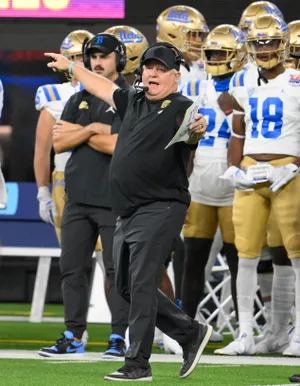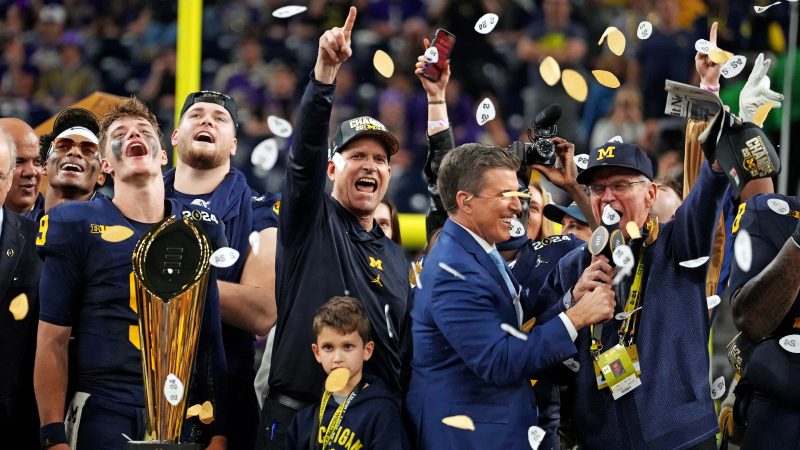College football coaching isn't nearing an apocalypse. It's changing, like every other job
Chip Kelly’s departure from UCLA last Friday to become the offensive coordinator at Ohio State marked the fourth time since the end of the season that a head coach willingly left a highly-paid position to do something other than lead a college football program.
It has led to a chorus of hand-wringing about the state of the sport, speculation about more coaches fleeing to the NFL or getting out altogether and the usual complaints about greedy players trying to leverage their ability to transfer freely for more money in name, image and likeness deals.
“The two weeks after we beat Rutgers was the two toughest weeks I’ve ever had as a college coach because of this portal, NIL, you know, your third-team tailback coming in saying I need $100,000 or I'm going into the portal," Maryland coach Mike Locksley said last week during a radio interview with 106.7 FM in Washington, D.C.
“You're like, 'Where is this magic $100,000 number coming from?' I sat in my office and every meeting I had was basically … 'I want this, I want that.' And the greatest team sport has now become kind of individualized, and I went home and was like, I don't know how much I can do this.”
While noting later in the interview that he was “not complaining” and is in favor of players being paid with “guardrails,” Locksley’s comments feed into a refrain that has become more and more familiar around the college landscape over the last couple of years: The job just isn’t what it used to be.

That's true. Just like the journalist, the computer programmer, the airline pilot or the dentist, few people leave an industry doing the same job the same way they did at the beginning of their careers. Most of us can relate to the idea that change in the workplace is hard, and not always for the better.
But the narrative that college football’s current state of semi-chaos will chase good people away from the profession is not just misleading, it’s being weaponized by people like Sen. Tommy Tuberville (R-Ala.), who is potentially in position to influence NIL reform in Congress.
In an op-ed last week for the conservative sports website “Outkick,” the former college football coach-turned-politician used the recent retirement of Nick Saban to justify a proposal that would, among other things, require an athlete to be at a university for three years before they can transfer.
“Coach Saban's retirement is a big loss for football fans, but the worst may be to come,” Tuberville wrote.
Oh, the humanity!
While it may be true that Saban was disenchanted with certain things that happened in college sports over the last few years, let’s be clear that he never said NIL or the transfer portal factored meaningfully into his decision. In fact, Saban expressly pushed back against that notion in an interview with ESPN, saying: "To me, if you choose to coach, you don't need to be complaining about all that stuff. You need to adjust to it and adapt to it and do the best you can under the circumstances.”
MORE:Grading every college football coaching hire this offseason from best to worst
Saban is 72 years old with seven national championships and more money than he could ever spend. His eventual retirement has been a major topic for nearly a decade. It’s completely normal for him to call it a career at this stage.
The same could be said for Jim Harbaugh's move from Michigan to the Los Angeles Chargers. When Harbaugh came back to his alma mater, there were questions about whether he would even make it to Year 5 before getting restless – something he had never done in his three previous coaching stops. He made it to Year 9, won his national title and bolted town amidst two NCAA investigations. Now he’ll try to add a Super Bowl, a goal he's never been shy about.
When Jeff Hafley left Boston College a couple of weeks ago to take the Green Bay Packers' defensive coordinator job, the news was accompanied on ESPN by an anonymous quote suggesting that Hafley wanted a job where all he had to do was coach football. “College coaching has become fundraising, NIL and recruiting your own team and transfers. There's no time to coach football anymore,” the person said.
Sorry, but when’s the last time being a college football coach was just about coaching? The 1960s? Maybe before that?
Reality check: The 44-year-old Hafley was 22-26 at Boston College, had three years left on his contract and would have been on the hot seat next season had he returned. He had also been an NFL assistant from 2012-2018, and it’s not a surprise that he preferred the NFL lifestyle, where coaches actually get an offseason, don't have to constantly jump on planes to recruit teenagers or attend cocktail parties to glad-hand boosters.
If he didn't like it, there were plenty of guys willing to take his place – including Bill O'Brien, who has jumped back and forth between the NFL and college for almost 20 years and was with the New England Patriots last season. So much for that narrative.
Kelly’s job change is by far the most head-scratching of the coaching carousel. You just don’t see head coaches at major programs like UCLA step down to take a college coordinator job, even at a behemoth like Ohio State. But Kelly, too, was about to enter a win-or-else season with a bad roster and little enthusiasm for recruiting – which was a problem long before NIL came into the picture. It's probably best for all parties that he moved on.
But these isolated and unrelated situations, combined with the longstanding tradition of college coaches complaining about anything and everything other than the direct deposits they’re getting, have made it convenient to weave a story that the profession is on the verge of an apocalypse.
The reality is, there’s never been a better time to be a college football coach. Guys at the top end of the sport are making $10 million per year on guaranteed contracts that are running for seven or eight years.
HOW MUCH DO THEY MAKE?Check out college football head coaches' salaries
But these days, simply becoming an FBS head coach or a coordinator at a top program is financially life-changing. Salaries of $1 million or more are now common, even at middling Group of Five programs. Even UNLV, a program that has barely cared about football for much of its existence, is now paying head coach Barry Odom $1.75 million annually.
Pretty good work if you can get it.
Yes, there are inconveniences. Yes, the schedule needs adjustments so coaches aren’t trying to cram recruiting, transfer portal, job changes and bowl prep into the month of December. Yes, a governing body with more authority to make its own rules would help them have a better grip on their roster.
But for decades, coaches have made out like bandits in this profession, even as the system was illegally preventing players from getting a piece of the pie. Now it’s a time of transition, and changes in the system are making coaches' jobs harder – the same way disruptions in every other industry have made people's jobs more complicated.
Welcome to the real world.

Disclaimer: The copyright of this article belongs to the original author. Reposting this article is solely for the purpose of information dissemination and does not constitute any investment advice. If there is any infringement, please contact us immediately. We will make corrections or deletions as necessary. Thank you.






